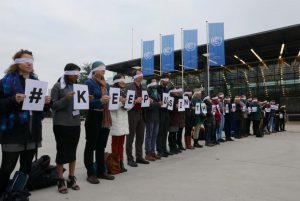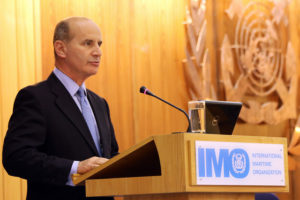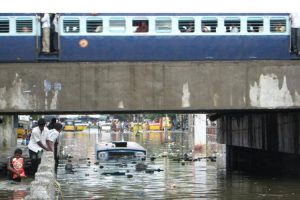The UN climate talks process is littered with the wreckage of past failures, including the much-hyped Copenhagen summit in 2009, which failed to forge agreement between big developed and developing world emitters on who should take on the burden of cuts in greenhouse gases (GHGs). This time around, a more ‘bottom-up’ approach has obliged countries to submit their carbon cutting plans as a basis of future carbon cuts. Meanwhile, big falls in the cost of low-carbon technology, and increasing co-operation between China and the US, has raised hopes that tireless French diplomacy will help haul almost 190 countries over the line. But major obstacles and potential elephant traps remain.
CD: How different will the willingness to negotiate in Paris be compared with Copenhagen in 2009?
BH: The probability of success is much better this time, as China has taken up a leadership role and has worked with the US on core issues, such as ways to cut emissions and co-operate on technology, such as energy efficiency and carbon capture. The US is also in a different space now from Copenhagen, and the process has gathered much more sophisticated support from the Obama administration this time around. The US and China, and many others, including the hosts France, have used a lot of their diplomatic capacity to build momentum towards a deal. Everyone knows we can’t have another Copenhagen. But there’s a long list of issues that could be big obstacles to an agreement, and achieving a deal will involve major challenges for political managers of the process. I fully expect that negotiations will spill over not only into Saturday 12 December, but also into the following day. The gathering of world leaders at the start, rather than the end of the conference, is an invaluable opportunity for impetus. But the danger is that heads of government make pronouncements that are difficult to reconcile. The publication of a text from the ADP (Durban Platform for Enhanced Action) strand of UN climate talks on December 5 will trigger a political process under the French presidency of the summit to resolve outstanding issues. It’s a critical stage that will greatly determine the final outcome.
CD: To what extent will the pledges so far, which fall well short of putting the world to meeting the 2C threshold, make it difficult for the most vulnerable countries to sign up to a deal?
BH: There are a lot of doubts about whether large emitters will ever be able to deliver the required ambition to put the world on the required path. It’s unlikely that a deal in Paris will be enough to convince the general public that countries have taken the necessary steps to avoid worsening impacts of climate change. Targets laid out in INDCs (climate plans submitted to the UN) only run up to 2030, and are far above the 1.5C threshold demanded by many small island states, or even hold below the 2C limit accepted by all countries. If there is an attempt to take the 1.5C limit off the table it could provoke a crisis. The actions outlined so far by all countries when taken together are headed at best to 2.7C, and are far from giving the world a likely chance of restricting a temperature rise to 2C – so getting regular five-year reviews into a final text will be a big issue.
CD: Besides the scale of emissions cuts, what will likely be the other main bugbears for most vulnerable countries?
BH: Countries most at risk of climate change are going to want to see a convincing financial package that has much greater clarity on the long term sources of funding and scale, and how it is going to be spent. Ministers from these nations will need to return home with something tangible. Vulnerable countries also want to see included in the agreement a separate provision for ‘loss and damage’ to provide resources and mechanisms to overcome permanent damage that will occur, over and above adaptation needs. Think this is something they will fight hard for despite the opposition of richer nations and big emitters. Some developing countries may resist a push by developed countries to impose universal standards of monitoring, reporting and verification (MRV), which they would regard as a backdoor attempt to bind them into emissions cuts.
CD: How will discussion about the legal status of the treaty likely play out in Paris?
BH: The US will clearly say that it can’t sign up to legally-binding specific emission reductions because that would require ratification by the Senate (which would almost certainly fail) but the most vulnerable countries will find it difficult to back an agreement that is non-legal in nature. Small island states and least developed countries will also not want to accept an agreement that lacks a five-year review mechanism, but even if that interval is agreed, there are questions of what a ‘ratchet’ or ‘review’ would entail. What do countries mean by a review, and will it involve obligations to deepen emissions cuts? Will countries commit to being publicly-bound to increasing the level of ambition of emissions cuts by 2020? And can these reviews close the emissions gap in time? If we don’t see sharply falling emissions during the next decade then will be very difficult, if not impossible to hold warming below 2C, let along 1.5C. The agreement needs to agree clear processes that would bend the emissions curve sharply lower.
CD: Previous climate talks have been hijacked by countries, or groups of countries, who have refused to engage with discussions on many of the main strands. Who is likely to be in the ‘awkward squad’ this time round?
BH: The Paris climate summit will definitely have several political ructions that might threaten an overall deal being done, and there’s always the risk that countries such as Venezuela, which has caused problems before, once again moves into a blocking position. The UNFCCC doesn’t have a lot of freedom to exclude countries from the process. It’s possible that Russia will raise barriers to agreement late in the day, but with Russia it’s always hard to tell. The Middle East oil producers certainly don’t like an undertaking to cap temperatures rises at 1.5C, and they will likely be joined by big consumers or producers of coal, such as Australia, South Korea, Japan to weaken moves to enshrine some kind of 2050 decarbonisation target in an agreement.
CD: Because of China’s bilateral deals with the US, India is now seen as the major developing world emitter that will need to be placated in Paris. What does it want?
BH: India’s role at the Paris climate talks will be crucial to their success – it will likely generate a lot of political noise and fears persist that it might become a ‘blocker’ in terms of overall ambition. India has a long shopping list of things it does not want – no 1.5C target (which could compel big emissions cuts from large developing countries) no five-year review by 2020, no legally binding clauses and many things it wants, including – clear access to finance and technology for adaptation and mitigation. India wants a great deal of flexibility. It is important to recognised that over the next decade, India is likely to have the fastest-growing electricity market among the largest economies in the world and that it faces a choice between going faster and harder towards renewable energy, with lower emissions, or a high emissions path with more coal. Current policies in India could mean its coal-fired power capacity reaches over 380 GW in 2030, far above the 230–250 GW consistent with a below 2C pathway.






